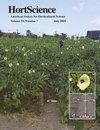Effect of Fungicides and Application Intervals for the Control of Black Spot of Roses
IF 1.5
3区 农林科学
Q2 HORTICULTURE
引用次数: 0
Abstract
The efficacy of the fungicide pydiflumetofen + difenoconazole (Postiva) was evaluated at varying application rates and intervals to control black spot disease (Diplocarpon rosae) in rose (Rosa spp. ‘Coral Drift’). Container-grown roses were arranged in a completely randomized design with five single-plant replications. Experiments were conducted under greenhouse and shade-house conditions (56% shade) in 2021/2022 and 2023. Black spot disease in roses was developed naturally. Pydiflumetofen + difenoconazole at 1.1 , 1.6, and 2.2 mL⋅L–1, and standard fungicide azoxystrobin + benzovindiflupyr (Mural) at 0.5⋅g L–1 were sprayed on foliage to runoff on a 2- or 4-week interval. Plants that were not treated with fungicide served as the controls. Plants were evaluated weekly for disease severity (0%–100% foliage affected) and defoliation (0%–100% defoliation). The season-long area under the disease progress curve (AUDPC) and area under the defoliation progress curve (AUDFC) were calculated for the evaluation period. Pydiflumetofen + difenoconazole reduced significantly black spot disease severity, AUDPC, defoliation, and AUDFC both in greenhouse and shade-house conditions compared with control plants, and was as effective as azoxystrobin + benzovindiflupyr. All the application rates and intervals of pydiflumetofen + difenoconazole were equally effective in reducing black spot severity and AUDPC. Our findings suggest that pydiflumetofen + difenoconazole at the lowest rate with the longest application interval is the most cost-effective, and has similar efficacy as treatments with higher rates and more frequent intervals.杀菌剂和施用间隔对控制玫瑰黑斑病的影响
在玫瑰(蔷薇属'珊瑚漂流')上防治黑斑病(Diplocarpon rosae)时,评估了不同施用量和施用间隔期的杀菌剂吡虫啉 + 二唑醇(Postiva)的药效。容器栽培的玫瑰采用完全随机设计,五个单株重复。实验于 2021/2022 年和 2023 年在温室和遮荫棚(遮荫率 56%)条件下进行。玫瑰黑斑病是自然发生的。以 1.1、1.6 和 2.2 mL⋅L-1 的剂量将啶氟菌唑+苯醚甲环唑和以 0.5⋅g L-1 的剂量将标准杀菌剂唑螨酯+苯并嘧啶氟吡啶(Mural)喷洒在叶面上,每隔 2 或 4 周喷洒一次。未使用杀菌剂的植物作为对照。每周对植株的病害严重程度(0%-100%叶片受影响)和落叶情况(0%-100%落叶)进行评估。在评估期间计算病害进展曲线下的季节面积(AUDPC)和落叶进展曲线下的面积(AUDFC)。与对照植物相比,啶虫脒+苯醚甲环唑在温室和荫棚条件下都能显著降低黑斑病的严重程度、AUDPC、落叶率和AUDFC,其效果与唑啉草酯+苯并嘧啶氟吡啶相当。吡虫啉+苯醚甲环唑的所有施用量和施用间隔对降低黑斑病严重程度和AUDPC同样有效。我们的研究结果表明,使用最低施药量和最长施药间隔期的吡虫啉+苯醚甲环唑最具成本效益,并且与使用较高施药量和较频繁施药间隔期的药效相似。
本文章由计算机程序翻译,如有差异,请以英文原文为准。
求助全文
约1分钟内获得全文
求助全文
来源期刊

Hortscience
农林科学-园艺
CiteScore
3.00
自引率
10.50%
发文量
224
审稿时长
3 months
期刊介绍:
HortScience publishes horticultural information of interest to a broad array of horticulturists. Its goals are to apprise horticultural scientists and others interested in horticulture of scientific and industry developments and of significant research, education, or extension findings or methods.
 求助内容:
求助内容: 应助结果提醒方式:
应助结果提醒方式:


